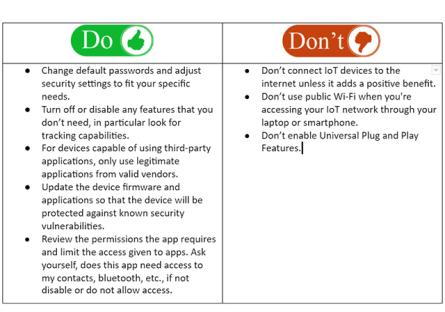
This year has seen major disruptions in the way we work, learn, and socialize, driving many of these activities online. With our homes, schools, and business more connected than ever, it’s vital to “Protect It” and #BeCyberSmart.
Do you own any of the 31 billion Internet of Things (IoT) devices? With the ability to connect to countless IoT applications, smart devices have begun to revolutionize the way we live and work. Every connected device you own can add another privacy/security concern, especially since most of them connect to your smartphone. From wearable fitness or medical devices to smart home appliances and beyond. As more devices get interconnected, securing them all will be a challenge, but the good news is that there are simple steps that you can take to reduce exposure and protect your network.
While you can’t necessarily avoid being targeted, you can greatly decrease your odds of compromise by taking a few simple steps. When setting up a new Internet of Things (IoT) device like a security camera, video door bell or thermostat:
Do
- Change default passwords and adjust security settings to fit your specific needs.
- Turn off or disable any features that you don’t need, in particular look for tracking capabilities.
- For devices capable of using third-party applications, only use legitimate applications from valid vendors.
- Update the device firmware and applications so that the device will be protected against known security vulnerabilities.
- Review the permissions the app requires and limit the access given to apps. Ask yourself, does this app need access to my contacts, bluetooth, etc., if not disable or do not allow access.
Don't
- Don’t connect IoT devices to the internet unless it adds a positive benefit.
- Don’t use public Wi-Fi when you're accessing your IoT network through your laptop or smartphone.
- Don’t enable Universal Plug and Play Features.